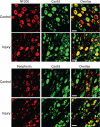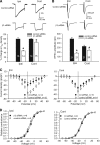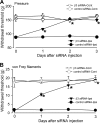Up-regulation of Cavβ3 subunit in primary sensory neurons increases voltage-activated Ca2+ channel activity and nociceptive input in neuropathic pain
- PMID: 22187436
- PMCID: PMC3285367
- DOI: 10.1074/jbc.M111.310110
Up-regulation of Cavβ3 subunit in primary sensory neurons increases voltage-activated Ca2+ channel activity and nociceptive input in neuropathic pain
Abstract
High voltage-activated calcium channels (HVACCs) are essential for synaptic and nociceptive transmission. Although blocking HVACCs can effectively reduce pain, this treatment strategy is associated with intolerable adverse effects. Neuronal HVACCs are typically composed of α(1), β (Cavβ), and α(2)δ subunits. The Cavβ subunit plays a crucial role in the membrane expression and gating properties of the pore-forming α(1) subunit. However, little is known about how nerve injury affects the expression and function of Cavβ subunits in primary sensory neurons. In this study, we found that Cavβ(3) and Cavβ(4) are the most prominent subtypes expressed in the rat dorsal root ganglion (DRG) and dorsal spinal cord. Spinal nerve ligation (SNL) in rats significantly increased mRNA and protein levels of the Cavβ(3), but not Cavβ(4), subunit in the DRG. SNL also significantly increased HVACC currents in small DRG neurons and monosynaptic excitatory postsynaptic currents of spinal dorsal horn neurons evoked from the dorsal root. Intrathecal injection of Cavβ(3)-specific siRNA significantly reduced HVACC currents in small DRG neurons and the amplitude of monosynaptic excitatory postsynaptic currents of dorsal horn neurons in SNL rats. Furthermore, intrathecal treatment with Cavβ(3)-specific siRNA normalized mechanical hyperalgesia and tactile allodynia caused by SNL but had no significant effect on the normal nociceptive threshold. Our findings provide novel evidence that increased expression of the Cavβ(3) subunit augments HVACC activity in primary sensory neurons and nociceptive input to dorsal horn neurons in neuropathic pain. Targeting the Cavβ(3) subunit at the spinal level represents an effective strategy for treating neuropathic pain.
Figures







Similar articles
-
Plasticity and emerging role of BKCa channels in nociceptive control in neuropathic pain.J Neurochem. 2009 Jul;110(1):352-62. doi: 10.1111/j.1471-4159.2009.06138.x. Epub 2009 Apr 30. J Neurochem. 2009. PMID: 19457113 Free PMC article.
-
α2δ-1 Upregulation in Primary Sensory Neurons Promotes NMDA Receptor-Mediated Glutamatergic Input in Resiniferatoxin-Induced Neuropathy.J Neurosci. 2021 Jul 7;41(27):5963-5978. doi: 10.1523/JNEUROSCI.0303-21.2021. Epub 2021 Jun 17. J Neurosci. 2021. PMID: 34252037 Free PMC article.
-
Upregulation of dorsal root ganglion (alpha)2(delta) calcium channel subunit and its correlation with allodynia in spinal nerve-injured rats.J Neurosci. 2001 Mar 15;21(6):1868-75. doi: 10.1523/JNEUROSCI.21-06-01868.2001. J Neurosci. 2001. PMID: 11245671 Free PMC article.
-
Presynaptic NMDA receptors control nociceptive transmission at the spinal cord level in neuropathic pain.Cell Mol Life Sci. 2019 May;76(10):1889-1899. doi: 10.1007/s00018-019-03047-y. Epub 2019 Feb 20. Cell Mol Life Sci. 2019. PMID: 30788514 Free PMC article. Review.
-
Calcineurin Regulates Synaptic Plasticity and Nociceptive Transmission at the Spinal Cord Level.Neuroscientist. 2022 Dec;28(6):628-638. doi: 10.1177/10738584211046888. Epub 2021 Nov 18. Neuroscientist. 2022. PMID: 34791930 Review.
Cited by
-
Genome-wide identification and functional analyses of microRNA signatures associated with cancer pain.EMBO Mol Med. 2013 Nov;5(11):1740-58. doi: 10.1002/emmm.201302797. Epub 2013 Oct 18. EMBO Mol Med. 2013. PMID: 24039159 Free PMC article.
-
α2δ-1 gene deletion affects somatosensory neuron function and delays mechanical hypersensitivity in response to peripheral nerve damage.J Neurosci. 2013 Oct 16;33(42):16412-26. doi: 10.1523/JNEUROSCI.1026-13.2013. J Neurosci. 2013. PMID: 24133248 Free PMC article.
-
Nerve injury induces a Gem-GTPase-dependent downregulation of P/Q-type Ca2+ channels contributing to neurite plasticity in dorsal root ganglion neurons.Pflugers Arch. 2015 Feb;467(2):351-66. doi: 10.1007/s00424-014-1520-4. Epub 2014 May 9. Pflugers Arch. 2015. PMID: 24809506
-
Decoupling of mRNA and Protein Expression in Aging Brains Reveals the Age-Dependent Adaptation of Specific Gene Subsets.Cells. 2023 Feb 14;12(4):615. doi: 10.3390/cells12040615. Cells. 2023. PMID: 36831282 Free PMC article.
-
Targeting the CaVα-CaVβ interaction yields an antagonist of the N-type CaV2.2 channel with broad antinociceptive efficacy.Pain. 2019 Jul;160(7):1644-1661. doi: 10.1097/j.pain.0000000000001524. Pain. 2019. PMID: 30933958 Free PMC article.
References
-
- Dworkin R. H., O'Connor A. B., Backonja M., Farrar J. T., Finnerup N. B., Jensen T. S., Kalso E. A., Loeser J. D., Miaskowski C., Nurmikko T. J., Portenoy R. K., Rice A. S., Stacey B. R., Treede R. D., Turk D. C., Wallace M. S. (2007) Pharmacologic management of neuropathic pain. Evidence-based recommendations. Pain 132, 237–251 - PubMed
-
- Campero M., Serra J., Marchettini P., Ochoa J. L. (1998) Ectopic impulse generation and autoexcitation in single myelinated afferent fibers in patients with peripheral neuropathy and positive sensory symptoms. Muscle Nerve 21, 1661–1667 - PubMed
-
- Gracely R. H., Lynch S. A., Bennett G. J. (1992) Painful neuropathy. Altered central processing maintained dynamically by peripheral input. Pain 51, 175–194 - PubMed
-
- Catterall W. A., Few A. P. (2008) Calcium channel regulation and presynaptic plasticity. Neuron 59, 882–901 - PubMed
-
- Catterall W. A. (2000) Structure and regulation of voltage-gated Ca2+ channels. Annu. Rev. Cell Dev. Biol. 16, 521–555 - PubMed
Publication types
MeSH terms
Substances
Grants and funding
LinkOut - more resources
Full Text Sources
Molecular Biology Databases
Miscellaneous

